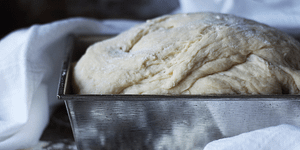Turkey Egg Rolls With Vietnamese Dipping Sauce

Looking for a unique way to cook with turkey this holiday season? This gluten-free and kosher recipe for turkey egg rolls is sure to impress everyone at the dinner table. Serve these easy-to-make appetizers with a side of Vietnamese dipping sauce for an extra kick of flavor!
The following is an excerpt from The Nourishing Asian Kitchen by Sophia Nguyen Eng. It has been adapted for the web.
RECIPE: Vietnamese Egg Rolls With Turkey
Unlike Chinese and Filipino egg rolls, which are typically filled with pork and wrapped with wheat-based wrappers, Vietnamese egg rolls are traditionally wrapped with rice paper and are deep-fried until crispy.
This recipe is kosher and gluten-free, which means we can share it with more of our family and friends. My mother and I gather around the table to wrap, and the children love making their own shapes and sizes.
These egg rolls are great to have in the freezer, ready to cook for a quick appetizer when guests come!
Ingredients
- 1/2 cup (10 g) dried wood ear mushrooms
- 4 ounces (115 g) mung bean noodles or glass noodles
- 1/2 cup (65 g) minced onion
- 1 cup (140 g) shredded carrot
- 6 garlic cloves, minced
- 1 large pasture-raised egg, beaten
- 1/4 cup (60 mL) fish sauce
- 1 teaspoon maple syrup
- 1 teaspoon fine sea salt
- 1 teaspoon ground black pepper
- 1 pound (450 g) ground turkey
- 20 to 25 (8-inch [20 cm]) rice paper wrappers
- Duck fat or avocado oil, for frying
- Vietnamese Dipping Sauce
Procedure
Put the dried mushrooms in a bowl, cover with warm water, and let soak for 1 hour. Drain and cut into small pieces. Rinse the mung bean noodles in hot water, then cut into shorter pieces.
In a large bowl, combine the mushrooms and noodles. Squeeze out the excess moisture from the onion by hand and add it to the bowl, along with the carrot, garlic, egg, fish sauce, maple syrup, salt, and pepper and mix thoroughly. Add the ground turkey and mix well.
Fill a large, shallow dish with warm water. Dip a rice paper wrapper into the water and let it soak for 5 to 10 seconds, until it is soft and pliable.
Place the wrapper on a clean, flat surface. Spoon 1 to 2 tablespoons (15–30 g) of the turkey mixture down the center of the wrapper. Fold the wrapper over the filling, tuck in the sides, then roll it up tightly, like a burrito. Repeat with the remaining wrappers and filling. Refrigerate for at least 30 minutes, or up to 4 hours.
In a large, deep skillet, add enough duck fat or oil to cover the egg rolls and heat over medium-low heat. Line a plate with paper towels. To check if the oil is ready, we do the “chopstick test.” Touch a chopstick to the bottom of the skillet, and you should see some bubbles forming.
Do not allow the oil to get too hot or you will burn the egg rolls. Working in batches so as not to crowd the pan, carefully add the egg rolls to the hot oil and cook until golden brown and crispy, 3 to 5 minutes. Using a spider or slotted spoon, transfer the egg rolls to the paper towels to drain.
Serve the egg rolls hot, with the dipping sauce.
RECIPE: Vietnamese Dipping Sauce

This is the Vietnamese dipping sauce that is often served with spring rolls, grilled meats, and many other dishes. Traditional nước chấm calls for sugar, but we have adapted this to use honey or maple syrup.
Note that the flavor may differ slightly from traditional nước chấm due to the natural sweetener used.
Ingredients
Yield: 2 cups (480 mL)
- 1/4 cup (60 mL) fish sauce
- 1/4 cup (60 mL) maple syrup or raw honey
- 2 tablespoons (30 mL) lime juice
- 1 tablespoon apple cider vinegar
- 1 garlic clove, minced
- 1 or 2 Thai chilies, sliced (optional)
- 2/3 cup (80 mL) spring water, warmed
Procedure
In a small bowl, whisk together the fish sauce, maple syrup, lime juice, vinegar, garlic, and chilies (if using) until the sweetener is dissolved. Stir in enough warm water to thin the sauce to your desired consistency. Taste and adjust the seasoning as needed.
Serve nước chấm in small bowls for dipping spring rolls and egg rolls, or pour it over a rice or noodle dish as a sauce. Store in an airtight container in the refrigerator for up to 6 months.
Recommended Reads
Recent Articles
Want to spice up your traditional bread recipes? This salt-rising bread recipe by fermentation expert Sandor Ellix Katz has all the simplicity, flavor, and uniqueness you’ve been searching for! The following is an excerpt from Sandor Katz’s Fermentation Journeys by Sandor Ellix Katz. It has been adapted for the web. What Is Salt-Rising Bread? Salt-rising…
Read MoreNothing says “spring” like a fresh, foraged meal! Savor the flavors of the season with this Milkweed Bud Pizza recipe.
Read MoreWhat’s so great about oyster mushrooms? First, you can add them to the list of foods that can be grown indoors! They are tasty, easy to grow, multiply fast, and they love a variety of substrates, making oyster mushrooms the premium choice. The following is an excerpt from Fresh Food from Small Spaces by R. J.…
Read More









